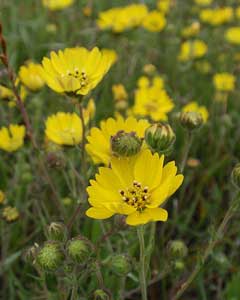 |
|
http://www.biolib.de/ |
 |
| http://www.flickr.com/photos/tomhilton/ |
Translate this page:
Summary
Physical Characteristics

 Madia sativa is a ANNUAL growing to 0.8 m (2ft 7in). It is in flower from July to August, and the seeds ripen from August to September. The species is monoecious (individual flowers are either male or female, but both sexes can be found on the same plant) and is pollinated by Insects.
Madia sativa is a ANNUAL growing to 0.8 m (2ft 7in). It is in flower from July to August, and the seeds ripen from August to September. The species is monoecious (individual flowers are either male or female, but both sexes can be found on the same plant) and is pollinated by Insects.
Suitable for: light (sandy), medium (loamy) and heavy (clay) soils and prefers well-drained soil. Suitable pH: mildly acid, neutral and basic (mildly alkaline) soils. It cannot grow in the shade. It prefers moist soil.
UK Hardiness Map
US Hardiness Map
Synonyms
M. viscosa.
Plant Habitats
Cultivated Beds;
Edible Uses
Edible Parts: Oil Oil Seed
Edible Uses: Oil Oil
Seed - raw or cooked[257]. Although quite small, the seed was a staple food for some native North American Indian tribes[257]. Rich in oil, it can be roasted then ground into a powder and eaten dry, mixed with water, or combined with cereal flours[94, 94, 183, 257]. The seed was also used as piñole[257]. The seed contains about 41% of a sweet edible oil, about 28% can be extracted from the seed in an oil press[2, 46, 61]. Of a high quality, it can be used as a substitute for olive oil[2, 183]. The oil does not solidify until the temperature drops to -11°c[95].
References More on Edible Uses
Medicinal Uses
Plants For A Future can not take any responsibility for any adverse effects from the use of plants. Always seek advice from a professional before using a plant medicinally.
None known
References More on Medicinal Uses
The Bookshop: Edible Plant Books
Our Latest books on Perennial Plants For Food Forests and Permaculture Gardens in paperback or digital formats.

Edible Tropical Plants
Food Forest Plants for Hotter Conditions: 250+ Plants For Tropical Food Forests & Permaculture Gardens.
More

Edible Temperate Plants
Plants for Your Food Forest: 500 Plants for Temperate Food Forests & Permaculture Gardens.
More

More Books
PFAF have eight books available in paperback and digital formats. Browse the shop for more information.
Shop Now
Other Uses
Oil Oil
The seed is rich in an oil which is a good substitute for olive oil. It does not solidify until the temperature is lower than -11°c. A good lubricant, the oil is also used in soap making[94, 95].
Special Uses
References More on Other Uses
Cultivation details
An easily grown plant[2], it succeeds in any good garden soil[1]. Prefers a deep open sharply drained soil in a sunny position[200]. This species is sometimes cultivated in Europe for the oil in its seed[2]. The flowers open in the morning or evening, closing when exposed to bright sunlight[200].
References Carbon Farming Information and Carbon Sequestration Information
Temperature Converter
Type a value in the Celsius field to convert the value to Fahrenheit:
Fahrenheit:
The PFAF Bookshop
Plants For A Future have a number of books available in paperback and digital form. Book titles include Edible Plants, Edible Perennials, Edible Trees,Edible Shrubs, Woodland Gardening, and Temperate Food Forest Plants. Our new book is Food Forest Plants For Hotter Conditions (Tropical and Sub-Tropical).
Shop Now
Plant Propagation
Seed - sow in mid spring in situ and only just cover the seed. Germination should take place within a couple of weeks.
Other Names
If available other names are mentioned here
Native Range
NORTHERN AMERICA: Canada (British Columbia), United States (Oregon, Washington, California) SOUTHERN AMERICA: Argentina (Mendoza, Chubut, Neuquén, Río Negro, Tierra del Fuego), Chile
Weed Potential
Right plant wrong place. We are currently updating this section.
Please note that a plant may be invasive in one area but may not in your area so it's worth checking.
Conservation Status
IUCN Red List of Threatened Plants Status :

Growth: S = slow M = medium F = fast. Soil: L = light (sandy) M = medium H = heavy (clay). pH: A = acid N = neutral B = basic (alkaline). Shade: F = full shade S = semi-shade N = no shade. Moisture: D = dry M = Moist We = wet Wa = water.
Now available:
Food Forest Plants for Mediterranean Conditions
350+ Perennial Plants For Mediterranean and Drier Food Forests and Permaculture Gardens.
[Paperback and eBook]
This is the third in Plants For A Future's series of plant guides for food forests tailored to
specific climate zones. Following volumes on temperate and tropical ecosystems, this book focuses
on species suited to Mediterranean conditions—regions with hot, dry summers and cool, wet winters,
often facing the added challenge of climate change.
Read More
Expert comment
Author
Molina.
Botanical References
69200
Links / References
For a list of references used on this page please go here
Readers comment